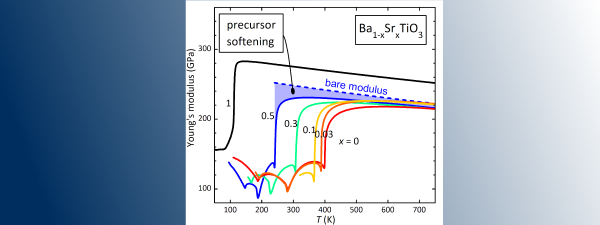We measured the Young’s moduli of BaTiO3, SrTiO3 and their solid solutions up to 850 K. Below the Curie temperature a series of ferroelectric and ferroelastic phase transitions is accompanied by elastic anomalies, but precursor softening (in blue) is also observed above Tc, that in Ba rich compositions extends up to the highest temperatures reached. The precursor softening can be fitted with a power law (T-Tc)^k where k ranges between 1.5 in SrTiO3 and 0.2 in BaTiO3. An alternative Vogel-Fulcher type analysis is also considered. The amplitude of the precursor softening increases continuously from SrTiO3 to BaTiO3 and is still 33% of the unsoftened Young’s modulus at 750 K in BaTiO3. This proves that the high temperature elastic properties of these materials are drastically affected by precursor softening.
Elastic precursor effects during the Ba1-xSrxTiO3 ferroelastic phase transitions
 Young’s moduli of BaTiO3, SrTiO3 and their solid solutions. Below the Curie temperature a series of ferroelectric and ferroelastic phase transitions is accompanied by elastic anomalies, but precursor softening (in blue) is also observed above Tc, that in Ba rich compositions extends up to the highest temperatures reached.
Physical Review Research
Young’s moduli of BaTiO3, SrTiO3 and their solid solutions. Below the Curie temperature a series of ferroelectric and ferroelastic phase transitions is accompanied by elastic anomalies, but precursor softening (in blue) is also observed above Tc, that in Ba rich compositions extends up to the highest temperatures reached.
Physical Review Research
“Elastic precursor effects during the Ba1-xSrxTiO3 ferroelastic phase transitions”, published in Physical Review Research, is the result of a collaboration between ISM-CNR, Cambridge Earth Sciences (Cambridge University - England), Federal University of São Carlos (UFSCar - Brazil) and Xi’an Jiaotong University (China).
The elastic softening in the paraelastic/paraelectric phases of Ba1-xSrxTiO3 extends to the highest measured temperature (850 K) for Ba-rich compounds and can be fitted with a power law (T-Tc)^k where k ranges between 1.5 in SrTiO3 and 0.2 in BaTiO3. An alternative Vogel-Fulcher type analysis is also considered. The amplitude of the precursor softening increases continuously from SrTiO3 to BaTiO3 and is still 33% of the unsoftened Young’s modulus at 750 K in BaTiO3. This proves that the high temperature elastic properties of these materials are drastically affected by precursor softening.

 English (UK)
English (UK)  Italiano (Italia)
Italiano (Italia)